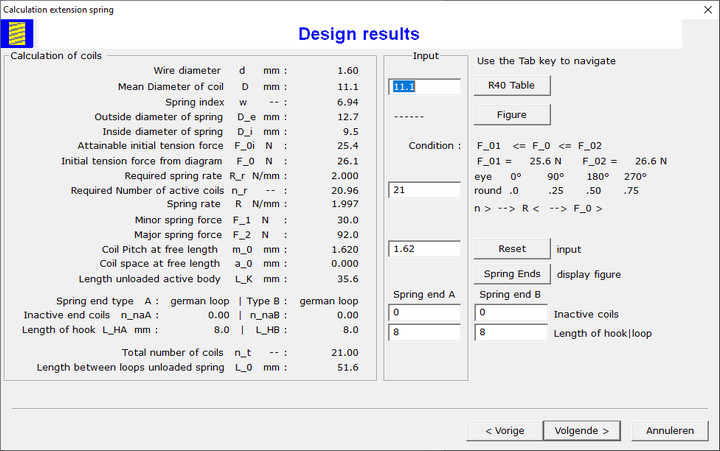Cylindrical Extension Springs
Design of an extension spring
The objective is to determine the wire diameter and the coil dimensions for a given axial spring force and stroke.
The dimensioning is done according the standard DIN EN 13906-2. The user is guided through the calculation operation by a wizard sheet.
Design Specifications
On opening of the wizard sheet, a wizard page with a list of spring wire grades is beeing displayed. A spring wire grade file
is supplied with the application. The file contains wire grades according the standards EN 10270-1, 2 and 3, EN 10089,
Copper-tin alloys EN12166. The user can update the spring wire grades file with data of the wires he will use.
Input design specifications with following wizard page:

In above figure you can see there are 2 ways for the input the spring load.
Case 1: input minor spring force F1, major spring force F2 and stroke sh.
Case 2: input minor spring force F1 with corresponding minor deflection s1 and stroke sh.
Input of the number of loading cycles Ncy and optional input as upper limit coil outside diameter De
and/or spring index w. Selections to do with radio buttons: cold or hot coiling, initial tension to apply, coiled with bank or automate, hand of coiling,
shot peening applied. Input of spring end type for spring ends A and B.
The application calculates the required wire diameter d. The user decides the wire diameter he's gonna to use.
Then the wizard page under neath is displayed on the screen with calculation results for the coil dimensions:

The user has to perform the input the coil mean diameter D, the number of active coils n and the
free state pitch m0. Input required for loop/hook dimensions for both spring ends A and B.
The calculation involves geometry, spring rate and strength. The calculation results are shown in the next wizard page. Go to the next web
page to see the design results and the spring diagram.